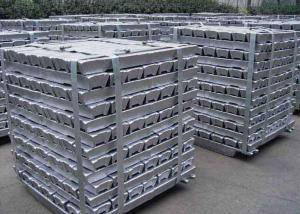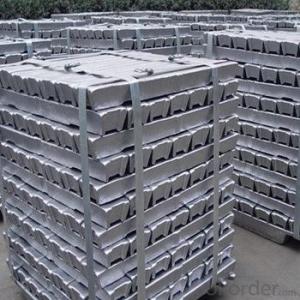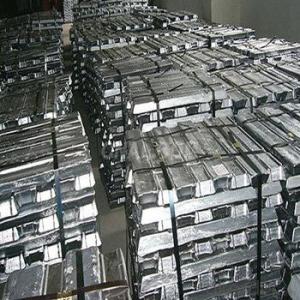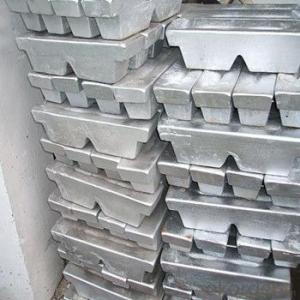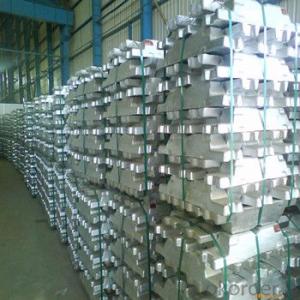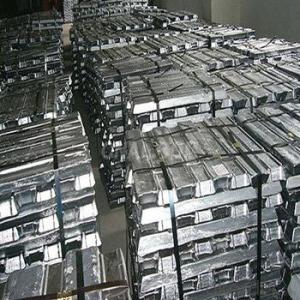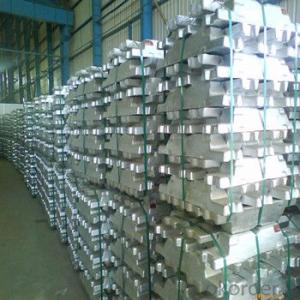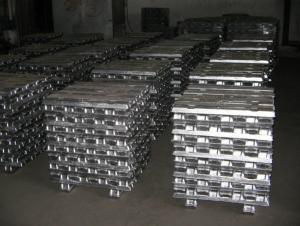Aluminum Ingots AA1050
- Loading Port:
- Shanghai
- Payment Terms:
- TT or LC
- Min Order Qty:
- 20 Tons m.t.
- Supply Capability:
- 1000 Sets Per Month m.t./month
OKorder Service Pledge
Quality Product, Order Online Tracking, Timely Delivery
OKorder Financial Service
Credit Rating, Credit Services, Credit Purchasing
You Might Also Like
1. Specifications of Aluminum Ingots AA1050
| Product Name | Aluminum Ingot |
| Chemical Composition | Al |
| Weight | 20/25kg |
| Al (Min) | 99%-99.9% |
| Appearance | silvery white |
| Advantages | easy control and operation, fast melting |
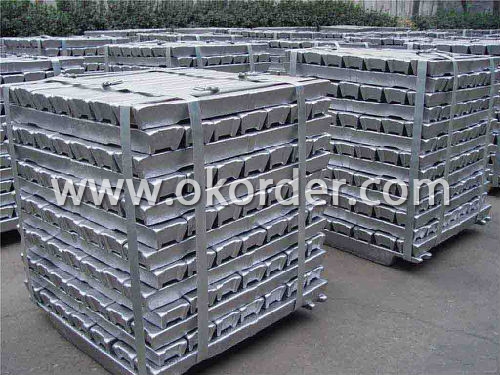
2. Usage/Application of Aluminum Ingots AA1050
A. mainly used for melting ingot
B. discontinuous melting with scrap
3.Packaging & Delivery of Aluminum Ingots AA1050
About 25Kg /Ingot, Packed in wooden case, Net weight 1000Kg/ Case, or as customer's requirements.

- Q:Why milling through milling machine before rolling aluminium ingot?
- I say the oxide film refers to the aluminum ingot when hot rolling or heating should not form excessive oxide film, otherwise it must be added after the hot rolling milling process;
- Q:What are the different shapes and sizes of aluminum ingots?
- The shapes and sizes of aluminum ingots can vary depending on the manufacturing process and intended use. Common shapes include rectangular, cylindrical, and trapezoidal. Sizes can range from small ingots weighing a few pounds to larger ones weighing several tons.
- Q:And aluminum liquid aluminum ingot related industries?
- The aluminum ingot process, also known as the metal aluminum process, is produced by directly passing the chlorine through the molten metal aluminum, which is directly contacted with each other. Aluminum production by AlCl3 has the advantages of simple process, less equipment, low investment unit. China's aluminum rich resources, the production of anhydrous aluminum chloride using basic aluminium ingot method.
- Q:How are impurities removed from aluminum ingots during production?
- Impurities are removed from aluminum ingots during production through a process called refining. The refining process typically involves two main steps: degassing and filtration. During degassing, the aluminum melt is subjected to high temperatures and low pressures. This helps in removing volatile impurities such as hydrogen, which can cause porosity and brittleness in the final product. The high temperature and low pressure conditions allow the impurities to escape as gas bubbles, which are then removed from the melt. Filtration is the next step in impurity removal. The aluminum melt is passed through a filtration system that contains ceramic filters or other porous materials. These filters are designed to trap solid impurities such as oxides, non-metallic particles, and other foreign materials. The filters have a specific pore size that allows only the molten aluminum to pass through while retaining the impurities. This filtration process helps in improving the quality of the aluminum by reducing the levels of non-metallic inclusions, which can negatively affect the mechanical properties of the final product. It also helps in controlling the grain structure and improving the overall homogeneity of the aluminum ingots. In addition to degassing and filtration, other refining techniques such as fluxing and electromagnetic stirring may also be employed depending on the specific requirements of the production process. Fluxing involves the addition of chemical compounds to the aluminum melt to facilitate the removal of impurities. Electromagnetic stirring uses electromagnetic fields to enhance the mixing and distribution of the melt, aiding in the removal of impurities. Overall, impurities are effectively removed from aluminum ingots during production through a combination of degassing, filtration, fluxing, and electromagnetic stirring processes. These refining techniques ensure that the final aluminum product meets the desired quality standards and exhibits optimal mechanical properties.
- Q:How to refine aluminum ingot
- Sales must not be a big problem, small and medium-sized aluminum factories will generally buy, but if you do not remove other components, and direct sell cans, there is no big difference in price.
- Q:What are the different surface finishes available for aluminum ingots?
- The different surface finishes available for aluminum ingots include mill finish, brushed finish, anodized finish, powder-coated finish, and polished finish.
- Q:What are the challenges in sourcing sustainable aluminum ingots?
- Sourcing sustainable aluminum ingots is not without its challenges. One of the main challenges is ensuring that the aluminum is produced in an environmentally-friendly manner. This involves minimizing the energy consumption and carbon emissions associated with the production process. Many aluminum smelters still rely on fossil fuels for energy, which can have a significant impact on the environment. Another challenge is verifying the origin of the aluminum. It is important to ensure that the raw materials used in the production of the ingots are ethically sourced and not linked to deforestation, human rights abuses, or conflict zones. This requires a robust and transparent supply chain that can trace the aluminum back to its source. In addition, there is a need to address the issue of waste and recycling. Aluminum is a highly recyclable material, but there are still significant amounts of aluminum waste that end up in landfills. Encouraging and incentivizing the recycling of aluminum is crucial to reducing the environmental impact of its production. Furthermore, the availability of sustainable aluminum ingots can be limited. Not all aluminum producers have adopted sustainable practices, and there may be a lack of supply in certain regions or industries. This can make it challenging for businesses to source sustainable aluminum ingots consistently. Overall, while there are challenges in sourcing sustainable aluminum ingots, it is essential to address these issues in order to promote a more environmentally-friendly and responsible aluminum industry. By working towards sustainable sourcing practices, we can reduce the environmental impact of aluminum production and contribute to a more sustainable future.
- Q:What are the main factors influencing the choice between aluminum ingots and aluminum castings?
- Several factors come into play when deciding between aluminum ingots and aluminum castings. To begin with, the shape and complexity of the final product are crucial. Simple shapes that need minimal machining or finishing are best suited for aluminum ingots. On the other hand, aluminum castings are preferred for intricate designs and complex geometries, as they offer more flexibility in achieving the desired shape. Mechanical properties also play a role in the decision. Aluminum ingots are commonly used when high strength and durability are important. This is because ingots undergo a controlled solidification process, resulting in a more uniform and predictable material structure. Castings, on the other hand, may have slight variations in material properties due to the casting process, making them suitable for applications that prioritize design intricacy over mechanical strength. Cost is another significant factor. Aluminum ingots generally have a lower initial cost compared to aluminum castings. However, castings may be more cost-effective in terms of reduced material waste and lower energy consumption during production. Additionally, the casting process allows for the consolidation of multiple components into a single casting, potentially reducing assembly costs. Production volume is also a determining factor. Aluminum ingots are commonly used for mass production as they can be easily extruded or rolled into various shapes. Castings, on the other hand, are better suited for low to medium volume production runs, as the casting process involves creating molds and may require more time and labor. Lastly, environmental impact and sustainability considerations may influence the decision. Both options are recyclable, but castings may have a slight advantage as they typically require less energy for production and generate less material waste during the manufacturing process. In summary, the choice between aluminum ingots and aluminum castings is influenced by factors such as the desired shape and complexity of the product, required mechanical properties, cost considerations, production volume, and environmental factors.
- Q:Can aluminum ingots be anodized?
- Aluminum ingots are capable of undergoing anodization. Anodization, an electrochemical procedure, yields a safeguarding oxide layer on the exterior of aluminum. This technique can be employed on aluminum ingots, sheets, or any other manifestations. Anodization boasts numerous advantages, including heightened resistance against corrosion, enhanced durability, and the potential to introduce color onto the surface. Moreover, the anodized layer enriches the aesthetic appeal of the aluminum and facilitates superior adhesion of paints or dyes. In summary, the anodization of aluminum ingots is a prevalent practice across diverse industries to augment both the properties and appearance of the metal.
- Q:What is the role of aluminum ingots in the production of aircraft engines?
- Aluminum ingots play a crucial role in the production of aircraft engines as they are used to manufacture various engine components. Aluminum, being lightweight and possessing excellent thermal conductivity and corrosion resistance, is an ideal material for aircraft engines. The ingots are melted and cast into different shapes to create parts such as engine casings, pistons, cylinder heads, and other structural components. These ingots provide strength and durability while helping to reduce the overall weight of the engine, resulting in improved fuel efficiency and performance of the aircraft.
We are a well-known enterprise specializing in the production and sales of aluminum sheets and coils.
Since the establishment of us, we have been devoted to setting up a good CIS and completely implementing ISO9001 quality management system.
1. Manufacturer Overview |
|
|---|---|
| Location | Henan,China |
| Year Established | 1993 |
| Annual Output Value | Above US$200 Million |
| Main Markets | Mid East;Eastern Europe;North America |
| Company Certifications | ISO 9001:2000;ISO 14001:2004;OHSAS 18001 |
2. Manufacturer Certificates |
|
|---|---|
| a) Certification Name | |
| Range | |
| Reference | |
| Validity Period | |
3. Manufacturer Capability |
|
|---|---|
| a)Trade Capacity | |
| Nearest Port | Shanghai |
| Export Percentage | 30%-50% |
| No.of Employees in Trade Department | 21-50 People |
| Language Spoken: | English;Chinese |
| b)Factory Information | |
| Factory Size: | Above 100,000 square meters |
| No. of Production Lines | Above 10 |
| Contract Manufacturing | OEM Service Offered;Design Service Offered |
| Product Price Range | Average |
Send your message to us
Aluminum Ingots AA1050
- Loading Port:
- Shanghai
- Payment Terms:
- TT or LC
- Min Order Qty:
- 20 Tons m.t.
- Supply Capability:
- 1000 Sets Per Month m.t./month
OKorder Service Pledge
Quality Product, Order Online Tracking, Timely Delivery
OKorder Financial Service
Credit Rating, Credit Services, Credit Purchasing
Similar products
New products
Hot products
Related keywords

